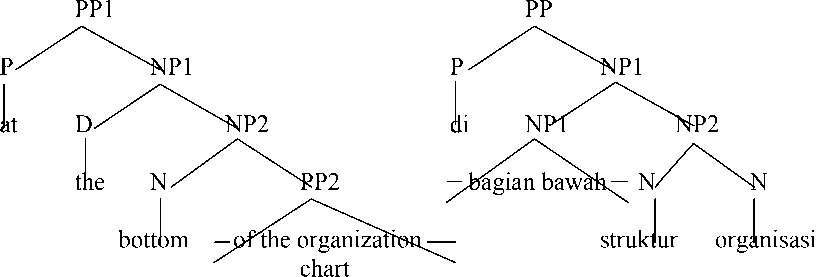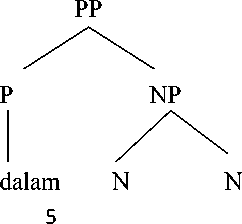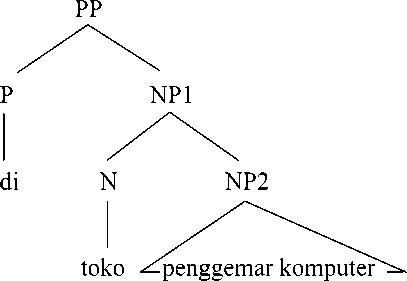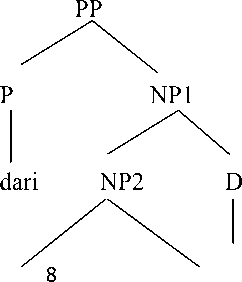THE ANALYSIS OF STRUCTURE SHIFT IN TRANSLATING LOCATIVE PREPOSITIONAL PHRASE INTO INDONESIAN
on
THE ANALYSIS OF STRUCTURE SHIFT IN TRANSLATING LOCATIVE PREPOSITIONAL PHRASE INTO INDONESIAN
Kadek Yogi Susana
Universitas Mahendradatta
Jl. Ken Arok No. 12 B Denpasar, Phone (0361) 434827
HP 081805512679
ABSTRACT
This research is mainly aimed to analyze the structure shift of locative prepositional phrase and its equivalences in Indonesian. The data of this study was taken from the biography of Steve Jobs. This book is published in English as the source language and in Indonesian as the target language. It is only the structure shift of locative prepositional phrase using preposition ‘at’, ‘in’, and ‘from’ is analyzed. The research is done through note taking technique in order to find and collect some data. In analyzing the data, translational identity method was applied that people use for comparing between one language with other language to find and analyze the equivalence (Sudaryanto, 1993). The main theory used to analyze the structure shift in translation of the biography of Steve Jobs is Translation Shift proposed by Catford (1965). The finding shows that the translation shift in this structure shift affects the process of translating locative prepositional phrase. Loss and gain information occurs in the process of translation from source language into target language.
Keywords: structure shift, translation, source language, target language.
ABSTRAK
Penelitian ini bertujuan untuk menganalisis pergeseran struktur dari frasa berkata depan tempat dan padanannya dalam bahasa Indonesia. Data penelitian ini diperoleh dari buku biografi yang berjudul Steve Jobs. Buku ini diterbitkan dalam bahasa Inggris sebagai bahasa sumber dan bahasa Indonesia sebagai bahasa sasarannya. Penulis hanya menganalisis pergeseran struktur dari frasa berkata depan tempat yang menggunakan kata depan ‘at’, ‘in’, dan ‘from’. Penelitian dilakukan dengan proses pencatatan untuk menemukan dan mengumpulkan beberapa data. Berkaitan dengan analisis data, penulis menggunakan metode identitas penerjemahan yaitu membandingkan satu bahasa dengan bahasa lain untuk menemukan dan menganalisis padanannya (Sudaryanto, 1993). Teori utama yang digunakan untuk menganalisis pergeseran struktur dalam penerjemahan buku biografi Steve Jobs yaitu teori Translation Shift yang dikemukakan oleh Catford (1965). Hasil penelitian menunjukkan bahwa pergeseran dalam hal ini pergeseran struktur mempengaruhi proses penerjemahan frasa berkata depan tempat. Pengurangan dan penambahan informasi terjadi dalam proses penerjemahan dari bahasa sumber ke dalam bahasa sasaran.
Kata kunci: pergeseran struktur, penerjemahan, bahasa sumber, bahasa sasaran.
INTRODUCTION
Recently translation process is very essential to be discussed as it is the way to understand
books written in foreign language. Many of those books cannot be successfully understood by the people as the target reader. In this study English is as the source language and Indonesian is as the target language. Nida as cited in (Venuti, 2000) states that since no two languages are identical, either in the meanings given to corresponding symbols or in the ways in which such symbols are arranged in phrases and sentences. It stands to reason that there can be no absolute correspondence between languages. Meanwhile Catford (1965) states that ‘shifts’ is departure from formal correspondence in the process of going from the source language to the target language. Sneddon (1996) states that locative prepositional phrase indicates position and direction. He further remarks that there are three basic locative prepositions which are ‘at’, ‘in’ and ‘on’. These three prepositions show that the action occurs in the place indicated by the following noun. In Indonesian, the three locative prepositions (‘at’, ‘in’, ‘from’) can be also combined with a set of locative noun which indicates location in relation to the following noun. These locative nouns include: atas (‘top’ or ‘above’); dalam (‘inside’); bawah (‘beneath’), depan (‘front’), samping (‘side’) (Sneddon, 1996).
Catford (1965) also states that there are two major types of shift: level shifts and category shifts. Category itself consists of structure shift, class shift, unit shift, and intra-system shift. A shift occurs when the source language text is translated into different grammatical or phonological form in the target language. Therefore shift possibly occurs in translation like in the process of translating biography of Steve Jobs. Regarding to this shift, it is expected that by recognizing it and the possibility of loss and gain of information the translator is able to transfer the message effectively. The emphasis is on the closest natural equivalence. The translator has to transfer the meaning and not the grammatical forms of the language. Transfer means reproducing information of the source language into the target language. It is realized that the result is not exactly the same, but equivalence namely a very close similarity in meaning. In translation, naturalness is essential as it makes the translation more acceptable.
The reason of why shift in translation is interesting to be discussed because structure shift in biography affects the transfer of meaning. However, many of us are still confused in understanding
the shifts in the translation from English into Indonesian. Therefore this study concerns on how the structure shift happen in translating locative prepositional phrases into Indonesian.
METHODS OF RESEARCH
The data of this study was taken from the biography of Steve Jobs (2011). This book is published in English as the source language and in Indonesian as the target language. Plenty of locative prepositional phrases were found in this book which contains structure shift in translation.
In this study, method of observation was applied. The data were collected by reading the locative prepositional phrases with structure shift. Note taking technique was applied by observing the list of the above data, identifying the types of shift implemented in the biography of Steve Jobs, classifying the selected data into three categories based on the analysis of locative prepositional phrases, and analyzing the data based on the related theories to the focus on the problem of study.
Translational identity method was applied in analyzing the data. Translation equivalent analysis was also conducted by examining how the English texts are translated into Indonesian. The translation shift occurred in the process of doing the translation from source language into target language was identified until the finding of loss and gain of information.
DISCUSSION
Here the analysis of structure shifts in translation of locative prepositional phrases found in Steve Jobs biography is presented. The locative prepositional phrase analyzed in this study is the locative prepositional phrase with prepositions ‘at’, ‘in’, and ‘from’ as the data of the study. The discussion of structure shift found in Steve Jobs biography is as follows:
Data 1
Source Language Text Target Language Text
Wozniak later said. “I could stay at the Kata Wozniak. “Aku bisa tetap berada bottom of the organization chart, as an di bagian bawah struktur organisasi, engineer.”(Pg. 77) sebagai seorang perekayasa perangkat
lunak.” (Pg. 101)
Here in source language, the locative prepositional phrase ‘at the bottom of the organization chart’ has the constitutions of preposition (at) + noun phrase (the bottom of the organization chart). The noun phrase is constituted out of definite article (the) + noun (bottom) + prepositional phrase (of the organization chart). With reference to the theory proposed by Radford (1988) the prepositional phrase can consist of Head and Specifier like the Head ‘at the bottom’ functions as locative prepositional phrase meanwhile Specifier ‘of the organization chart’ functions as complement prepositional phrase of noun phrase ‘the bottom’. In the target language, the locative prepositional phrase ‘di bagian bawah struktur organisasi’ has the constitutions of preposition (di) + noun phrase (bagian bawah struktur organisasi). The noun phrase is constituted out of adjective phrase (bagian bawah) + noun phrase (struktur organisasi).
This English locative prepositional phrase and its Indonesian equivalent can be syntactically depicted as follows:
Locative Prepositional Phrase in SL Locative Prepositional Phrase in TL
(at the bottom of the organization chart) (di bagian bawah struktur organisasi)

Based on the theory proposed by Catford (1965) we can find that the structure shift occurs in phonological and graphological translation as well as in total translation. Regarding to the theory proposed by Nida (1975), it is stated that loss of information means the translator does not explain the whole information in the target language or is not translated or transferred into the target language. From the previous study Sariyana (2009) finds that the principle of loss and gain of information would be inevitable in the translation process. The noun phrase, ‘the organization chart’ in source language which is translated into noun phrase, ‘struktur organisasi’ contains
structure shift and it is shown by different arrangement of noun phrase, ‘organization’ (modifier) + ‘chart’ (head) in source language and noun phrase, ‘struktur ‘(head) + ‘organisasi’ (modifier). This syntactical difference occurs as English commonly has the structure system of noun phrase by modifier + head but Indonesian has the structure system of noun phrase by head + modifier. The loss of information is shown by definite article ‘the’ is not translated in target language. Actually definite article ‘the’ can mean ‘ini’ or ‘itu’ ‘ini’ Indonesian which may influence the meaning literally.
Data 2
Jobs briefly fell for the joke and even took pride that the Apple II stacked up well against the Zaltair in the comparison chart. (Pg. 81)
Sesaat Jobs memercayai lelucon tersebut, dan bahkan bangga karena Apple jauh lebih unggul dibandingkan dengan Zaltaire dalam grafik perbandingan. (Pg. 105)
Here in source language, the locative prepositional phrase ‘in the comparison chart’ has the constitutions of preposition (in) + noun phrase (the comparison chart). The noun phrase is constituted out of definite article (the) + epithet noun (comparison) + noun (chart). In the target language, the locative prepositional phrase ‘dalam grafik perbandingan’ has the constitutions of preposition (dalam) + noun phrase (grafik perbandingan). The noun phrase is constituted out of noun (grafik) + epithet noun (perbandingan).
This English locative prepositional phrase and its Indonesian equivalent can be syntactically depicted as follow:
Locative Prepositional Phrase in SL (in the comparison chart)
Locative Prepositional Phrase in TL (dalam grafik perbandingan)
PP

P NP1

in D NP2


the N N grafik perbandingan comparison chart
With reference to the theory proposed by Catford (1965) we can find that structure shift occurs in phonological and graphological translation as well as in total translation. From the previous study Nurjana (2006) finds that the form that occurs in SL is not always translated into the same form in TL. Nida (1975) states that loss of information means the translator does not explain the whole information in the target language or is not translated or transferred into the target language. There is a structure shift which is shown by the translation of noun phrase ‘comparison chart’ into ‘grafik perbandingan’. We can find different form of both noun phrase ‘comparison’ (modifier) + ‘chart’ (head) in source language and noun phrase, ‘grafik’ (head) + ‘perbandingan’ (modifier). This syntactical difference occurs as English has the structure system of noun phrase by modifier + head but Indonesian has the structure system of noun phrase by head + modifier. Then there is also loss of information found in this data. It is shown by definite article ‘the’ which is not translated in target language. Actually definite article ‘the’ can mean ‘ini’ or ‘itu’ in Indonesian which may influence the meaning literally.
Data 3
As Regis McKenna later said, “Woz designed a great machine, but it would be sitting in hobby shops today …(Pg. 85)
Peran Jobs diperkuat oleh Regis McKenna yang menyatakan, “Woz mendesain sebuah mesin yang hebat. Akan tetapi mesin hebat itu hanya akan dijual di toko penggemar komputer saat ini …(Pg. 110)
In source language, the locative prepositional phrase ‘in hobby shops’ has the constitutions
of preposition (in) + noun phrase (hobby shops). The noun phrase is constituted out of epithet noun 6
(hobby) + plural noun (shops). In the target language, the locative prepositional phrase ‘di toko
penggemar komputer’ has the constitutions of preposition (di) + noun phrase (toko penggemar
komputer). The noun phrase is constituted out of noun (toko) + noun phrase (penggemar komputer).
This English locative prepositional phrase and its Indonesian equivalent can be syntactically
depicted as follow:
Locative Prepositional Phrase in SL (in hobby shops)
Locative Prepositional Phrase in TL (di toko penggemar komputer)
PP

P NP

in N N
hobby shops

In the theory proposed by Catford (1965) we can find that structure shift occurs in
phonological and graphological translation as well as in total translation. Regarding to the theory proposed by Nida (1975), it is stated that loss of information means the translator does not explain the whole information in the target language or is not translated or transferred into the target language. From the previous study Sariyana (2009) finds that the principle of loss and gain of information would be inevitable in the translation process. The lexical identification shows that instead of translating the locative prepositional phrase ‘in hobby shops’ into ‘di toko hobi’ in the target language which is generally the term for it. The translator translates that locative prepositional phrase into ‘di toko penggemar computer’. Here there is structure shift which is shown by the translation of noun phrase ‘hobby shop’s into ‘toko penggemar komputer’. We can find different form of both noun phrases, ‘hobby’ (modifier) + ‘shops’ (head) in source language and noun phrase, ‘toko’ (head) + ‘penggemar komputer’ (modifier). This syntactical difference occurs as English has the structure system of noun phrase by modifier + head but Indonesian has the structure system of noun phrase by head + modifier. The loss of information happens in translating
plural noun ‘shops’ into singular noun ‘toko’ in the target language of the above locative prepositional phrase. Here the information from the concept of plural noun is lost in the target language. There is also loss of information when the modifier ‘hobby’ is translated into ‘penggemar komputer’. The word ‘hobby’ which means a favorite activity that a person does for pleasure and not as her or his regular businesses may vary in many kinds of activity as stated (Hornby, 1995). So the word ‘hobby’ is more general than ‘penggemar computer’ which means favorite activity of computer only.
Data 4
In later years Jobs whole-widget approach would distinguish the iPhone, iPod, and iPad from their competitors. (Pg. 137)
Beberapa tahun kemudian, pendekatan alat yang dilakukan secara menyeluruh juga akan membedakan iPhone, iPod, dan iPad dari para pesaing mereka. (Pg. 176)
In source language, the locative prepositional phrase ‘from their competitors’ has the
constitutions of preposition (from) + noun phrase (their competitors). The noun phrase is
constituted out of pronoun (their) + plural noun (competitors). In the target language, the locative
prepositional phrase ‘dari para pesaing mereka’ has the constitutions of preposition (dari) + noun
phrase (para pesaing mereka). The noun phrase is constituted out of noun phrase (para pesaing) +
pronoun (mereka). This English locative prepositional phrase and its Indonesian equivalent can be
syntactically depicted as follow:
Locative Prepositional Phrase in SL (from their competitors)
Locative Prepositional Phrase in TL (dari para pesaing mereka)
PP

P NP

their competitors
para pesaing mereka
Based on the theory proposed by Catford (1965) we can find that the structure shift occurs in phonological and graphological translation as well as in total translation. From the previous study Al-Zoubi and Al-Hasnawi (2001) find that the phenomenon of shift should be redefined positively as the consequence of the translator’s effort to establish translation equivalence between two different language systems: that of the source language and that of the target language. In the above data there is structure shift occurs in the process of translating locative prepositional phrase ‘from their competitors’ into locative prepositional phrase ‘dari para pesaing mereka’ in Indonesian. The evidence is the noun phrase ‘their competitors’ in source language which is translated into noun phrase ‘para pesaing mereka’ in target language. They have different form; ‘their’ (modifier) + ‘competitors’ (head) in source language and ‘para pesaing’ (head) + ‘mereka’ (modifier). This syntactical difference occurs as English has the structure system of noun phrase by modifier + head but Indonesian has the structure system of noun phrase by head + modifier. Actually in term of translation equivalence, there is no loss, gain or skewing of information. The translator successfully transfers the meaning of plural noun. It seems the translator knows about the concept of plural noun in English as shown in the word ‘competitors’ and replaced with the phrase ‘para pesaing’ which is in Indonesian means plural noun as well.
CONCLUSION
In translating English biography into Indonesian it is found that the phenomenon of structure shift is unavoidable as the translator tries to establish the equivalence between two language systems. The system of source language is often different with the target language. Here the structure shift is applied by the translator in order to anticipate the loss of meaning when rendering a text, to connect the information successfully, and to make the translation result acceptable for the target reader. Translation is about the transfer of meaning therefore the analysis of structure shift is
important for book producer, translator or even the target reader to get the closest natural equivalence.
REFERENCE
Al-Zoubi & Al-Hassnawi. 2001. Constructing a Model for Shift Analysis in Translation. Translation Journal. Jordan: Irbid National University
Catford, J. C. 1965. A Linguistic Theory of Translation. London: Oxford University Press.
Hornby, A.S. 1995. Oxford Advanced Learner’s Dictionary of Current English. Oxford: Oxford University Press.
Nida, Eugene A. and Charles R. Taber. 1975. Theory and Practice of Translation. California: Stamford University Press.
Nurjana Putra, I Dewa Made. 2006. The Analysis of Prepositional Adjective in the Translation of ‘The Adventure of Tom Sawyer’ by Mark Twain into ‘Petualangan Tom Sawyer’ by Djokolelono. Thesis. Denpasar: Udayana University
Radford, A. 1988. Transformational Grammar. Great Britain: Cambridge Univesrsity Press.
Sariyana, Putu. 2009. The Preposition ‘Of’ in Noun Phrase Construction an Its Translation into Indonesian. Thesis. Denpasar: Udayana University
Sneddon, J.M. 1996. Indonesian Reference Grammar. Brisbane: Griffith University
Sudaryanto. 1993. Metode dan Aneka Teknik Analisis Bahasa. Jakarta: Duta Wacana University Press.
Translation Service, World++ & Tim Bentang. Steve Jobs. 2011. Yogyakarta: Penerbit Bentang
Venuti, L. 2000. The Translation Studies Reader. London& New York: Routledge.
10
Discussion and feedback